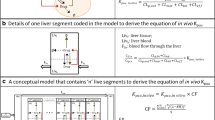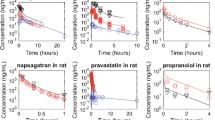Abstract
This report reviews concepts related to operation of the classic parallel-tube model (PTM) for hepatic disposition and examines two recent proposals of a newly derived equation to describe hepatic clearance (CLH). It is demonstrated that the proposed equation is identical to a re-arrangement of an earlier relationship from Pang and Rowland and provides a means of calculation of intrinsic clearance (CLint,PTM) rather than CLH as posed. We further demonstrate how classic hepatic clearance models with an assumed CLint, while subject to numerous limitations, remain highly useful and necessary in both traditional pharmacokinetics (PK) and physiologically based pharmacokinetic (PBPK) modeling.

Similar content being viewed by others
Notes
Interestingly, the lowest CLH values are often less than CLint,PTM. It is commonly expected that CLH approaches CLint,PTM when the latter becomes very small. However, this requires that QH > > CLint,PTM as can be found with Eq. 2. A similar phenomenon occurs with the WSM. Of course, adding fub will usually produce lower values of fub x CLint,PTM operative in the more complete models of hepatic clearance. This type of behavior was demonstrated previously in simulations by Winkler et al. (5).
Benet et al. (10) pose that amount eliminated per unit of time/systemic concentration is the “one valid definition of CL.” While this is a correct and mechanistically operative relationship for hepatic metabolism, perhaps a more general definition of a clearance process is velocity/substrate concentration as long appreciated (5). The latter is more useful in recognizing clearance processes (viz. Eq. 1 versus 2), allows for relationships such as Eq. 6, and helps in designation of transport and flow/permeability distribution clearances versus elimination clearances.
References
Miller NA, Reddy MB, Heikkinen AE, Lukacova V, Parrott N. Physiologically based pharmacokinetic modeling for first-in-human predictions: an updated model building strategy illustrated with challenging industry case studies. Clin Pharmacokin. 2019;58:727–46.
Halifax D, Foster JA, Houston JB. Prediction of human metabolic clearance from in vitro systems: retrospective analysis and prospective view. Pharm Res. 2010;27:2150–61.
Rowland M, Benet LZ, Graham GG. Clearance concepts in pharmacokinetics. J Pharmacokin Biopharm. 1973;1:123–36.
Wilkinson GR, Shand DG. A physiological approach to hepatic drug clearance. Clin Pharmacol Ther. 1975;18:377–90.
Winkler K, Keiding S, Tygstrup N, Clearance as a quantitative measure of liver function. In, “The Liver: Quantitative Aspects of Structure and Function”, pp 144–155, Karger-Basel 1973.
Bass L, Keiding S, Winkler K, Tygstrup N. Enzymatic elimination of substrates flowing through the intact liver. J Theoret Biol. 1976;61:393–409.
Pang KS and Rowland M, Hepatic clearance of drugs. I. Theoretical considerations of a “well-stirred” and a “parallel tube” model. Influence of hepatic blood flow, plasma and blood binding, and the hepatocellular enzymatic activity on hepatic drug clearance. J Pharmacokin Biopharm 1977; 5: 625–653.
Pang KS and Rowland M, Hepatic clearance of drugs. II. Experimental evidence for acceptance of the “well-stirred” model over the “parallel tube” model using lidocaine in the perfused rat liver in situ preparation, J Pharmacokin Biopharm 1977; 5:655–680.
Kochak GM. Critical analysis of hepatic clearance based on an advection mass transfer model and mass balance. J Pharm Sci. 2020;109:2059–69.
Benet LZ, Sodhi JK, Makrygiorgos G, Mesbah A. There is only one valid definition of clearance: critical examination of clearance concepts reveals the potential for errors in clinical drug dosing. AAPS J. 2021;23:67.
Sodhi JK, Wang H-J, Benet LZ. Are there any experimental perfusion data that preferentially support the dispersion and parallel-tube models over the well-stirred model of organ elimination? Drug Metab Dispos. 2020;48:537–43.
Pang KS, Han YR, Noh K, Lee PI, and Rowland M, Hepatic clearance concepts and misconceptions: why the well-stirred model is still used even though it is not physiological reality? Biochem Pharmacol 2019; 169: 113596.
Schneck DW, Pritchard JF, Hayes AH Jr. Studies on the uptake and binding of propranolol by rat tissues. J Pharmacol Exp Ther. 1977;203(3):621–9.
Katayama H, Fujiwara J, Yasuhara M, Okumura K, Hori R. Increased availability of propranolol in rats with uranyl nitrate-induced acute renal failure. J Pharmacobiodyn. 1984;7(8):536–44.
Shibasaki S, Asahina M, Kawamata Y, Kojo M, Nishigaki R, Umemura K. The inhibitory effects of cimetidine on elimination and distribution of propranolol in rats. J Pharmacobiodyn. 1989;12(9):549–57.
Singh K, Tripp SL, Dunton AW, Douglas FL, Rakhit A. Determination of in vivo hepatic extraction ratio from in vitro metabolism by rat hepatocytes. Drug Metab Dispos. 1991;19:990–6.
Suzuki T, Isozaki S, Ohkuma T, Rikihisa T. Influence of the route of administration on the mean hepatic extraction ratio of propranolol in the rat. J Pharm-Dyn. 1980;3:603–11.
Hung DY, Siebert GA, Chang P, Whitehouse MW, Fletcher L, Crawford DHG, Roberts MS. Hepatic pharmacokinetics of propranolol in rats with adjuvant-induced systemic inflammation. Am J Physiol Gastrointest Liver Physiol. 2006;290:G343–51.
Shand DG and Rangno RE, The disposition of propranolol. I. Elimination during oral absorption in man. Pharmacology 1972; 7: 159–68.
Gibaldi M, Boyes RN, Feldman S. Influence of first-pass effect on availability of drugs on oral administration. J Pharm Sci. 1971;60:1338–40.
Bischoff K, Dedrick RL. Thiopental pharmacokinetics. J Pharm Sci. 1968;57:1346–51.
Bischoff KB, Dedrick RL, Zaharko DS. Preliminary model for methotrexate pharmacokinetics. J Pharm Sci. 1970;59:149–54.
Cao Y, Jusko WJ. Applications of minimal physiologically-based pharmacokinetic models. J Pharmacokin Pharmacodyn. 2012;39:711–23.
Kusuhara H, Sugiyama Y. In vitro – in vivo extrapolation of transporter-mediated clearance in the liver and kidney. Drug Metab Pharmacokin. 2009;24:37–52.
Cheng H, Jusko WJ. Pharmacokinetics of reversible metabolic systems. Biopharm Drug Disp. 1993;14:721–66.
Roberts MS, Magnusson BM, Burczynski FJ, Weiss M. Enterohepatic circulation: Physiological, pharmacokinetic and clinical implications. Clin Pharmacokinet. 2002;41:751–90.
Zhang D, Wei C, Hop CECA, Wright MR, Hu M, Lai Y, Khojasteh SC, Humphreys WG. Intestinal excretion, intestinal recirculation, and renal tubule reabsorption are underappreciated mechanisms that drive the distribution and pharmacokinetic behavior of small molecule drugs. J Med Chem. 2021;64:7045–59.
Chow FS, Piekoszewski W, Jusko WJ. Effect of hematocrit and albumin concentration on hepatic clearance of tacrolimus (FK 506) during rabbit liver perfusion. Drug Metab Disp. 1997;25:610–6.
Jeong Y-S, Yin C-S, Ryu H-M, Noh C-K, Song Y-K, Chung S-J. Estimation of the minimum permeability coefficient in rats for perfusion-limited tissue distribution in whole-body physiologically-based pharmacokinetics. Eur J Pharmaceu Biopharm. 2017;115:1–17.
Li N. Badrinarayanan, Isida K, Li X, Roberts J, Wang S, Hayashi M, and Gupta A, Albumin-mediated uptake improves human clearance prediction for hepatic uptake transporter substrates aiding a mechanistic in vitro-in vivo extrapolation (IVIVE) in discovery research. AAPS J. 2021;23:1.
Baker M, Parton T. Kinetic determinants of hepatic clearance: plasma protein binding and hepatic uptake. Xenobiotica. 2008;37:1110–34.
Pang KS, Sherman IA, Schwab AJ, Geng W, Barker F 3rd, Dlugosz JA, Currier G, Goresky CA. Role of the hepatic artery in the metabolism of phenacetin and acetaminophen: intravital microscopic and multiple indicator dilution study in perfused rat liver. Hepatology. 1994;20:672–83.
Dahl G, Akerud T. Pharmacokinetics and the drug-target residence time concept. Drug Discovery Today. 2013;18:697–707.
Cao Y, Balthasar JP, Jusko WJ. Second-generation minimal physiologically-based pharmacokinetic model for monoclonal antibodies. J Pharmacokin Pharmacodyn. 2013;40:597–607.
Bowman CM, Benet LZ. An examination of protein binding and protein-facilitated uptake relating to in vitro-in vivo extrapolation. Eur J Pharm Sci. 2018;123:502–14.
Jusko WJ, Molins EAG, Ayyar VS. Seeking nonspecific binding: assessing the reliability of tissue dilutions for calculating fraction unbound. Drug Metab Disp. 2020;48:894–902.
Acknowledgements
WJJ acknowledges that he was a reviewer for the Benet et al. (10) publication and regrets that he did not catch the indicated problems at that time. The authors appreciate review comments by Dr. Yoo-Seong Jeong.
Funding
This work was supported by NIH Grant R35 GM131800.
Author information
Authors and Affiliations
Contributions
WJJ performed most of the literature assessment and writing while XL provided calculations and manuscript revisions.
The authors declare no competing interests.
Corresponding author
Additional information
Publisher's Note
Springer Nature remains neutral with regard to jurisdictional claims in published maps and institutional affiliations.
Rights and permissions
About this article
Cite this article
Jusko, W.J., Li, X. Assessment of the Kochak-Benet Equation for Hepatic Clearance for the Parallel-Tube Model: Relevance of Classic Clearance Concepts in PK and PBPK. AAPS J 24, 5 (2022). https://doi.org/10.1208/s12248-021-00656-z
Received:
Accepted:
Published:
DOI: https://doi.org/10.1208/s12248-021-00656-z




